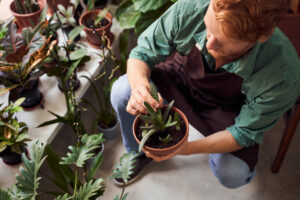Greetings to all you passionate gardeners out there! While winter may bring its chilly temperatures and shorter days, don’t let that dampen your gardening spirits. Instead, seize this golden opportunity to breathe life into your garden dreams by kickstarting your vegetable seeds indoors. I can assure you, there’s an unparalleled satisfaction in nurturing plants from humble seeds to bountiful harvests. So, cozy up with a cup of cocoa, and let’s embark on a thrilling journey into the realm of winter seed starting!
Why Start Early?
First things first, why should you bother starting your vegetable seeds indoors during the winter months? Well, here are a few compelling reasons.
Extend Your Growing Season: By starting seeds early, you can get a jump on the growing season, which means earlier harvests and more bountiful crops.
Greater Variety: Starting seeds indoors allows you to grow a wider range of vegetables, including those that might not thrive in your local climate if directly sown outdoors.
Better Control: You have complete control over the growing conditions, ensuring that your precious plants get the best start in life.
What to Start With?
Choosing the right vegetables to start indoors in winter is crucial. Here’s a list of some beginner-friendly options:
Tomatoes: These are a classic choice for seed starting. There’s nothing like the taste of homegrown tomatoes!
Peppers: Bell peppers, chili peppers – take your pick! Starting these indoors will give you a head start on the growing season.
Herbs: Basil, cilantro, parsley, and other herbs do well when started indoors. Plus, they’ll add a burst of flavor to your dishes.
Broccoli: Cold-hardy broccoli can be started indoors, and it’s a great choice for early spring harvesting.
Lettuce: Leafy greens like lettuce and spinach can be started indoors, and they’re perfect for salads.
Cabbage: Like broccoli, cabbage thrives in cooler temperatures and can be started indoors for early spring harvests.
Cucumbers: Grow delicious cucumbers indoors and transfer them to your garden when the weather warms up.
What You’ll Need:
Before you dive into seed starting, make sure you have these essentials on hand:
Seeds: Start with high-quality seeds from a reputable source. Check the seed packets for specific instructions on planting depth and spacing.
Containers: You can use seed trays, peat pots, or even recycled yogurt cups with drainage holes. Just make sure they’re clean.
Seed Starting Mix: Choose a sterile seed starting mix to provide a disease-free environment for your seeds.

Light Source: Natural light is ideal, but if you don’t have access to a sunny window, consider using fluorescent grow lights.
Heat Mat: Some seeds require a bit of extra warmth to germinate, so a heat mat can be a game-changer.
How to Sow Them:
Fill your containers with the seed starting mix, leaving about half an inch of space at the top.
Follow the instructions on the seed packet for planting depth and spacing. Typically, you’ll plant seeds at a depth of 2-3 times their diameter.
Water your seeds gently but thoroughly. A spray bottle works great for this.
Cover your containers with plastic wrap or a clear plastic lid to create a mini-greenhouse effect.
Place your containers in a warm spot with good airflow and provide them with the right amount of light.
How to Care for Them:
Once your seeds are sown, here are some key care tips:
Light: Ensure your seedlings get 12-16 hours of light daily. Adjust the height of your grow lights to keep them about 2-4 inches above the plants.
Watering: Keep the soil consistently moist but not waterlogged. Use a spray bottle to avoid disturbing the delicate seedlings.
Temperature: Maintain a steady temperature between 65-75°F (18-24°C). A heat mat can help if your home is cooler.

Thinning: Once your seedlings have a few sets of true leaves, thin them out to ensure proper spacing and prevent overcrowding.
Troubleshooting Tips:
Even experienced gardeners face challenges sometimes. Here are some common issues and how to tackle them:
Leggy Seedlings: If your seedlings are tall and spindly, they may need more light. Adjust the light source to be closer to the plants.

Damping Off: This fungal disease can kill seedlings. Ensure good ventilation, and avoid overwatering.
Yellowing Leaves: Yellow leaves can indicate nutrient deficiencies. Consider using a balanced fertilizer as directed on the package.
Pests: Keep an eye out for aphids, mites, or other pests. Use insecticidal soap or neem oil to combat them.
So there you have it, folks! Starting vegetable seeds indoors in the winter is a fantastic way to get a head start on your garden and brighten up those gloomy winter days. Plus, it’s a rewarding hobby that brings you closer to your food source. So, grab your seeds, containers, and a dash of enthusiasm – let’s grow some greens and watch them flourish! Happy gardening!
-
 Tempting Tomatoes® Patio Sunshine – Cherry Tomato – Solanum lycopersicum$8.50
Tempting Tomatoes® Patio Sunshine – Cherry Tomato – Solanum lycopersicum$8.50 -
 Tempting Tomatoes® Bellini – Cocktail Tomato – Solanum lycopersicum$8.50
Tempting Tomatoes® Bellini – Cocktail Tomato – Solanum lycopersicum$8.50 -
 Dragon Tongue – Bush Bean – Phaseolus vulgaris$8.50
Dragon Tongue – Bush Bean – Phaseolus vulgaris$8.50 -
 Proven Harvest® Tasty Marinara Collection$19.00
Proven Harvest® Tasty Marinara Collection$19.00 -
 Proven Harvest® Patio Collection$23.00
Proven Harvest® Patio Collection$23.00 -
 Proven Harvest® Tempting Tomatoes™ Collection$19.00
Proven Harvest® Tempting Tomatoes™ Collection$19.00 -
 Berried Treasure® Pink – Strawberry – Fragaria ananassa$8.50
Berried Treasure® Pink – Strawberry – Fragaria ananassa$8.50 -
 Proven Harvest® Classic Collection$23.00
Proven Harvest® Classic Collection$23.00 -
 Fire Away® Hot and Heavy – Hot Pepper – Capsicum annuum$8.50
Fire Away® Hot and Heavy – Hot Pepper – Capsicum annuum$8.50
More Recent Posts
Selling Plants Online has Never Been Easier
Going back to the pandemic, the consumer horticulture industry gained over 18 million new gardeners and plant parents. This is a significant amount of new interest in the wonderful world of plants. Garden centers, growers and home hobbyists all had to make this hard pivot to online sales in 2020. Since then, many garden retailers…
The Future of Consumer Horticulture
When it comes to consumer horticulture, there are countless factors that can contribute to its popularity and growth. From new consumer trends and innovative marketing strategies to technological advancements and consumer confidence, there is no shortage of potential factors at play. One company that is helping to drive consumer horticulture into the future is Ship…
Ship My Plants VS.
For Plant People, By Plant People Ship My Plants is the go-to marketplace for plant enthusiasts. Cultivated by a longtime love of horticulture, our multi-vendor platform offers a unique solution to buy and sell plants online. Unified Plant Data Backed by the industry’s leading plant database, Ship My Plants provides unified information across 30,000+ plant…




